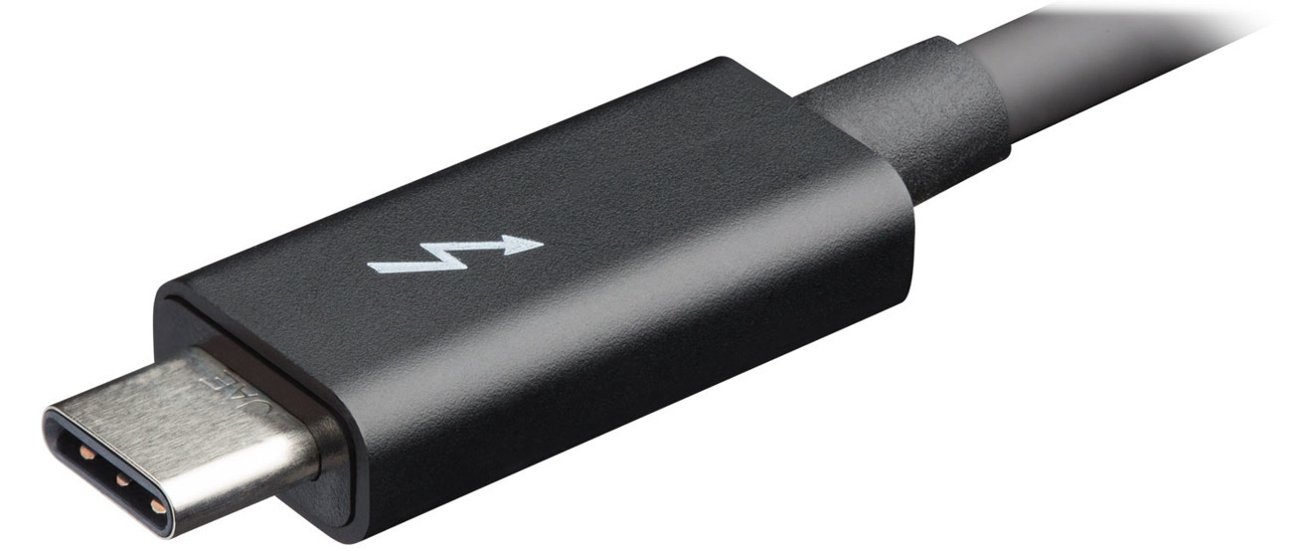Thunderbolt 5 details leak via deleted Twitter photo by Intel executive
A tweet from an Intel executive has tweeted then deleted an image that showed off some details about the in-development Thunderbolt 5, including that Intel is aiming to double the existing Thunderbolt bandwidth limits to 80Gbps.

An early Sunday tweet was posted by EVP and GM of Intel Client Computing Group Gregory Bryant has prompted speculation about the future of Thunderbolt as a communications technology. The executive posted a collection of four images from a visit to Intel's Israel research and development hub, but quietly deleted one of the photographs.
Seen by Anandtech, the image was wiped from Twitter as it includes a poster in the background that details what is believed to be Thunderbolt 5. The poster imparts a few key pieces of information about the connection's operation, including that it is tentatively called "USB 80G."
Despite not stating Thuderbolt at all on the poster, Bryan's tweet mentions it was a Thunderbolt-related lab tour. Also, given the closeness of Thunderbolt and USB by Intel allowing the Thunderbolt 3 specification to be part of the USB 4 standard, it seems highly plausible the poster is about Thunderbolt 5.

An image deleted from Twitter originally published by Intel's Gregory Bryant
According to the poster in the image, the connection is "targeted to support the existing USB-C ecosystem," which means Intel plans to continue using the USB Type-C connection.
An unusual element of the poster is a mention of its use of a "novel PAM-3 modulation technology." This indicates Intel is keen to try a completely different system for transmitting bits than normal.
Normally, the data line transmits one bit at a time, with an electrical signal switching between two states, also known as NRZ encoding. An alternative, Pulse-Amplitude Modulation 4 (PAM-4) mentions how two bits can be transferred at a time, with the 4 referring to the number of pairs of bits it can produce.
PAM-3 differs in that a data line can move between three states, covering 0, +1, or a -1. A pair of transmissions tells the system what a group of three bits are, giving an efficiency around 50% greater than NRZ.
To consumers, Thunderbolt 5 should theoretically provide many of the existing benefits of Thunderbolt 3 including power delivery, video,Thunderbolt networking, and high amounts of bandwidth. In the case of Thunderbolt 5, the doubled bandwidth from 40Gbps to 80Gbps will enable faster file transfers, as well as sustaining high-data communications between connected devices with fewer limitations.
Apple's current products support Thunderbolt 3. While some accessories have been released with Thunderbolt 4 support, it may be a while before Apple moves over to the standard.
It remains to be seen when Thunderbolt 5 will be formally introduced, but the unexpected leak at least offers a hint of what to expect from the standard's arrival.
Read on AppleInsider

An early Sunday tweet was posted by EVP and GM of Intel Client Computing Group Gregory Bryant has prompted speculation about the future of Thunderbolt as a communications technology. The executive posted a collection of four images from a visit to Intel's Israel research and development hub, but quietly deleted one of the photographs.
Seen by Anandtech, the image was wiped from Twitter as it includes a poster in the background that details what is believed to be Thunderbolt 5. The poster imparts a few key pieces of information about the connection's operation, including that it is tentatively called "USB 80G."
Despite not stating Thuderbolt at all on the poster, Bryan's tweet mentions it was a Thunderbolt-related lab tour. Also, given the closeness of Thunderbolt and USB by Intel allowing the Thunderbolt 3 specification to be part of the USB 4 standard, it seems highly plausible the poster is about Thunderbolt 5.

An image deleted from Twitter originally published by Intel's Gregory Bryant
According to the poster in the image, the connection is "targeted to support the existing USB-C ecosystem," which means Intel plans to continue using the USB Type-C connection.
An unusual element of the poster is a mention of its use of a "novel PAM-3 modulation technology." This indicates Intel is keen to try a completely different system for transmitting bits than normal.
Normally, the data line transmits one bit at a time, with an electrical signal switching between two states, also known as NRZ encoding. An alternative, Pulse-Amplitude Modulation 4 (PAM-4) mentions how two bits can be transferred at a time, with the 4 referring to the number of pairs of bits it can produce.
PAM-3 differs in that a data line can move between three states, covering 0, +1, or a -1. A pair of transmissions tells the system what a group of three bits are, giving an efficiency around 50% greater than NRZ.
To consumers, Thunderbolt 5 should theoretically provide many of the existing benefits of Thunderbolt 3 including power delivery, video,Thunderbolt networking, and high amounts of bandwidth. In the case of Thunderbolt 5, the doubled bandwidth from 40Gbps to 80Gbps will enable faster file transfers, as well as sustaining high-data communications between connected devices with fewer limitations.
Apple's current products support Thunderbolt 3. While some accessories have been released with Thunderbolt 4 support, it may be a while before Apple moves over to the standard.
It remains to be seen when Thunderbolt 5 will be formally introduced, but the unexpected leak at least offers a hint of what to expect from the standard's arrival.
Read on AppleInsider

Comments
I truly believed that LIghtning was a superior connector over USB-C (male into female), and the satisfying "click" is ...well, satisfying. But... I've had so much grief with Lightning on three separate iPhones. The inside connectors seem to be bend and no longer make contact with the plug contacts. It's been super frustrating on my previous two SE's... and now on my XR... so now I use Qi charging exclusively for my XR.
I'm warming up to USB-C now that I've had some experience with it on a few devices.
Existing cables without the MagSafe design would still function perfectly in MagSafe ports, as would MagSafe cables in non-MagSafe ports, but without the added benefit of magnetic retention.
Maybe call the MagSafe compatible cables USB-C(m) or something to distinguish them from standard USB-C. Yeah, I know that there are already too many variations of USB-C compatibility, so maybe it’s time to provide more clarity across the board for things like power delivery and Thunderbolt compatibility, e.g., USB-C(p), USB-C(t), etc.
I wouldn’t want to put magnets in the cables because it would drive up demand for rare earth magnets to unsustainable levels.
im sure if you spent a decade with USB C you’d find a new set of problems.
I believe the perfect shape is cylindrical.
The problem with USB C is it's a mess - you have one connector for power, USB 3, USB 4, TB 3, TB 4 and now possibly TB 5. All this means you don't know what you have when you see a USB C port, and you don't know what you can do with a USB C cable. In the end it's not much better, and in some ways worse than having separate connectors.
That could all be solved with this newish invention they call "writing"
MagSafe is already proprietary, the optical connector could replace the physical port which inherently compromises the case integrity.
I think it may have more to do with the anti-intellectual conservative ones who never learned how to read.